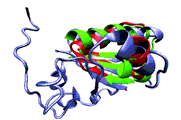Department of Chemistry
Document Type
Article
Date of this Version
5-5-2010
Citation
J Am Chem Soc. 2010 May 5; 132(17): 5930–5931. doi:10.1021/ja910778p.
Abstract
Hyperthermophilic archaea are of great interest in evolutionary microbiology, owing to their ability to withstand high temperatures, and often extremes of pressure, pH and salinity. Enzymes from these organisms1 may offer particular opportunities for asymmetric synthesis, complementary to approaches with mesophilic enzymes,2 or those involving enzyme3 and pathway4 reengineering. However, perhaps due to a bias that hyperthermophilic enzymes have “narrow substrate specificities,”5 archaeal extremophiles remain a largely untapped resource in asymmetric synthesis.6
Herein, we disclose a remarkably general Dynamic Reductive Kinetic Resolution (DYRKR) entry into (S)-profens, including several important NSAIDs. The enzyme employed is alcohol dehydrogenase (ADH)-10, one of 13 annotated ADHs in the hyperthermophile Sulfolobus solfataricus. Protein phylogenetic analysis of this paralogous family indicates SsADH-10 is most closely related to homologues in distant taxa (Fig. 1). The highest identity between SsADH-10 and any other SsADHs is only 34%, suggesting that the SsADH family was established prior to the emergence of other archaeal lineages. Though not described as such, the SsADH-10 appears to be the only SsADH isozyme for which structural information is available in the pdb.7



Comments
Copyright 2010. Used by permission.